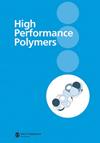Effect of thermally induced microstructural changes on the mechanical properties and ballistic performance of poly (p-phenylene terephthalamide) fibers
IF 1.6
4区 化学
Q3 POLYMER SCIENCE
引用次数: 1
Abstract
Microstructural variations have a strong influence on the load transfer capacity of the high-performance polymeric fibers, which is also reflected in their ballistic property changes. The focus of the present study is to investigate thermally induced microstructural changes and their reflection on the mechanical properties and theoretical ballistic limit of poly (p-phenylene terephthalamide) fibers by a correlation. From the quantitative analysis of XRD, thermally induced changes in unit cell a-dimension show profound sensitivity in affecting the tenacity and modulus of the fibers. Based on the physicochemical changes in FTIR and FESEM analysis, significant surface deterioration and changes in the chemical network are observed. However, dimensional variations of the crystal structure along a-direction show a stronger influence than the chemical and morphological changes, reflecting sigmoidal responses with tenacity, modulus and theoretical V50 by correlations. As an effect of unit cell dimensional variation, changes in crystallinity are resulted and lead to the loss in theoretical ballistic limit of the fibers by following first-order kinetics. Lastly, angular separation and (200) orientation angle are determined to build a global correlation with modulus and theoretical ballistic limit for quickly decoding macro-changes in terms of micro-properties. The given correlations can help to identify crystallographic transformations upon other induction techniques and view their effect on mechanical and ballistic parameters. In addition, the given approach can be extended for different ballistic materials under any environmental conditions. Graphical Abstract热致显微结构变化对聚对苯二甲酸乙二胺纤维力学性能和弹道性能的影响
微观结构的变化对高性能聚合物纤维的载荷传递能力有很大影响,这也反映在其弹道性能的变化上。本研究的重点是通过相关性研究热诱导的微观结构变化及其对聚对苯二甲酰胺纤维力学性能和理论弹道极限的反映。从XRD的定量分析来看,热致晶胞a尺寸的变化对纤维的韧性和模量的影响表现出极大的敏感性。基于FTIR和FESEM分析中的物理化学变化,观察到显著的表面劣化和化学网络的变化。然而,晶体结构沿a方向的尺寸变化显示出比化学和形态变化更强的影响,通过相关性反映了具有韧性、模量和理论V50的S形响应。作为晶胞尺寸变化的影响,结晶度发生变化,并通过遵循一阶动力学导致纤维的理论弹道极限损失。最后,确定角分离和(200)取向角,以建立与模量和理论弹道极限的全局相关性,从而根据微观特性快速解码宏观变化。给定的相关性可以帮助识别其他诱导技术上的晶体转变,并观察它们对机械和弹道参数的影响。此外,所给出的方法可以扩展到任何环境条件下的不同弹道材料。图形摘要
本文章由计算机程序翻译,如有差异,请以英文原文为准。
求助全文
约1分钟内获得全文
求助全文
来源期刊

High Performance Polymers
化学-高分子科学
CiteScore
4.20
自引率
14.30%
发文量
106
审稿时长
1.2 months
期刊介绍:
Health Services Management Research (HSMR) is an authoritative international peer-reviewed journal which publishes theoretically and empirically rigorous research on questions of enduring interest to health-care organizations and systems throughout the world. Examining the real issues confronting health services management, it provides an independent view and cutting edge evidence-based research to guide policy-making and management decision-making. HSMR aims to be a forum serving an international community of academics and researchers on the one hand and healthcare managers, executives, policymakers and clinicians and all health professionals on the other. HSMR wants to make a substantial contribution to both research and managerial practice, with particular emphasis placed on publishing studies which offer actionable findings and on promoting knowledge mobilisation toward theoretical advances. All papers are expected to be of interest and relevance to an international audience. HSMR aims at enhance communication between academics and practitioners concerned with developing, implementing, and analysing health management issues, reforms and innovations primarily in European health systems and in all countries with developed health systems. Papers can report research undertaken in a single country, but they need to locate and explain their findings in an international context, and in international literature.
 求助内容:
求助内容: 应助结果提醒方式:
应助结果提醒方式:


